Property from a Private French Collector Raoul Dufy Follow Nu dans l'atelier de la place Arago à Perpignan signed "Raoul Dufy" lower right oil on canvas 25 5/8 x 31 7/8 in. (65 x 81 cm.) Painted circa 1946, this work is accompanied by a certificate of authenticity dated November 14, 2013. Fanny Guillon-Laffaille has kindly confirmed the authenticity of this work, which will be included in her forthcoming second supplement to the Catalogue Raisonné of Paintings currently in preparation.
Condition Report Request Condition Report Thank you for your request. The Condition Report will be sent shortly. Contact Us * Required Send me the Report Via Email Fax Contact Specialist Cancel Provenance Collection Pierre Bourdouil, Domaine de Jau Galerie de Paris, Toulouse (acquired in 1961) Madame Hirst, Chateau de Cazals Acquired from the above by the present owner Catalogue Essay The following selection of nine masterworks by Raoul Dufy previously housed in the same private collection since their acquisition by the present owner nearly thirty years ago, showcases the French painter’s lifelong homage to the joy and color of life. In each of these works, the eternally carefree and uplifting nature of Dufy’s inimitable style is evident, and together, the following selection of works serves as a testament to the taste with which they were collected by the present owner. Though Dufy interacted with and was influenced by the contemporaneous currents in art, including Fauvism and Cubism, he maintained his independence as an artist and forged his own path to develop an aesthetic that is distinctly, and enduringly, his own. His entire oeuvre can be viewed as an aspiration towards light, and his serenely painted renderings of nature and people are imbued with irony, grandeur and wit. Characterized by the artist’s love for all that is vibrant in life, the works in this impressive group span his influential career and demonstrate many of the themes Dufy explored with his graceful, poetic charm. Reflecting on his relationship with these exceptional works, the present owner explained: "Dufy has allowed me to uncover the true meaning of happiness, and has instilled in me a desire and capacity to transform any vision of the world into terrestrial joy." Painted in 1906 at the height of his Fauve period, Le port du Havre showcases Dufy’s lifelong love of the sea and his distinct use of color. Born in Le Havre, the Normandy port town depicted in the present work, Dufy owed his love of the sea to the city where he spent all of his childhood and adolescence. The years of 1906-07 saw a period of intense experimentation for Dufy when he first coined his theory ‘couleur-lumière’, which he would apply to his entire oeuvre: “I was spontaneously led towards what was to become my real preoccupation. I had discovered a system, whose theory was this: to follow the light of the sun is a waste of time. Light in painting is something completely different: it is a light distributed throughout the composition, a ‘couleur-lumière’” (the artist, quoted in Dora Perez-Tibi, Dufy , New York, 1989, p. 24). In the summer of 1906, Dufy worked alongside Albert Marquet one of the original Fauves, in the seaside towns of Le Havre, Trouville and Honfleur. Marquet guided the artist during these months as Dufy experimented with color to depict a departure from reality, using it in an expressive, rather than descriptive, technique. The rich chromatism that Dufy developed during this period is evident in Le port du Havre in the bright green, orange and purple hues that highlight the boats and the windows of the portside buildings. Though Dufy’s Fauve period was brief, spanning only the years of 1906-07, the artist retained the stylistic qualities that he learned during this time, such as the paring down of subjects and his taste for color, applying them to his work throughout his career. In Paris, two retrospectives in 1907 of cubist painter Paul Cézanne’s work, one at the Salon d’Automne and the other at Galerie Bernheim-Jeune, inspired many artists of the time, including Dufy, to explore the principles central to Cézanne - the use of perspective and the visual representation of space on a flat surface. Believing the Euclidean perspective inherited from the Renaissance to be too mathematical and inflexible, Dufy explained: “Might it not be interesting to return, in order to take it a step further, to the study of perspective as conditioned by the specific demands of th
Property from a Private French Collector Raoul Dufy Follow Nu dans l'atelier de la place Arago à Perpignan signed "Raoul Dufy" lower right oil on canvas 25 5/8 x 31 7/8 in. (65 x 81 cm.) Painted circa 1946, this work is accompanied by a certificate of authenticity dated November 14, 2013. Fanny Guillon-Laffaille has kindly confirmed the authenticity of this work, which will be included in her forthcoming second supplement to the Catalogue Raisonné of Paintings currently in preparation.
Condition Report Request Condition Report Thank you for your request. The Condition Report will be sent shortly. Contact Us * Required Send me the Report Via Email Fax Contact Specialist Cancel Provenance Collection Pierre Bourdouil, Domaine de Jau Galerie de Paris, Toulouse (acquired in 1961) Madame Hirst, Chateau de Cazals Acquired from the above by the present owner Catalogue Essay The following selection of nine masterworks by Raoul Dufy previously housed in the same private collection since their acquisition by the present owner nearly thirty years ago, showcases the French painter’s lifelong homage to the joy and color of life. In each of these works, the eternally carefree and uplifting nature of Dufy’s inimitable style is evident, and together, the following selection of works serves as a testament to the taste with which they were collected by the present owner. Though Dufy interacted with and was influenced by the contemporaneous currents in art, including Fauvism and Cubism, he maintained his independence as an artist and forged his own path to develop an aesthetic that is distinctly, and enduringly, his own. His entire oeuvre can be viewed as an aspiration towards light, and his serenely painted renderings of nature and people are imbued with irony, grandeur and wit. Characterized by the artist’s love for all that is vibrant in life, the works in this impressive group span his influential career and demonstrate many of the themes Dufy explored with his graceful, poetic charm. Reflecting on his relationship with these exceptional works, the present owner explained: "Dufy has allowed me to uncover the true meaning of happiness, and has instilled in me a desire and capacity to transform any vision of the world into terrestrial joy." Painted in 1906 at the height of his Fauve period, Le port du Havre showcases Dufy’s lifelong love of the sea and his distinct use of color. Born in Le Havre, the Normandy port town depicted in the present work, Dufy owed his love of the sea to the city where he spent all of his childhood and adolescence. The years of 1906-07 saw a period of intense experimentation for Dufy when he first coined his theory ‘couleur-lumière’, which he would apply to his entire oeuvre: “I was spontaneously led towards what was to become my real preoccupation. I had discovered a system, whose theory was this: to follow the light of the sun is a waste of time. Light in painting is something completely different: it is a light distributed throughout the composition, a ‘couleur-lumière’” (the artist, quoted in Dora Perez-Tibi, Dufy , New York, 1989, p. 24). In the summer of 1906, Dufy worked alongside Albert Marquet one of the original Fauves, in the seaside towns of Le Havre, Trouville and Honfleur. Marquet guided the artist during these months as Dufy experimented with color to depict a departure from reality, using it in an expressive, rather than descriptive, technique. The rich chromatism that Dufy developed during this period is evident in Le port du Havre in the bright green, orange and purple hues that highlight the boats and the windows of the portside buildings. Though Dufy’s Fauve period was brief, spanning only the years of 1906-07, the artist retained the stylistic qualities that he learned during this time, such as the paring down of subjects and his taste for color, applying them to his work throughout his career. In Paris, two retrospectives in 1907 of cubist painter Paul Cézanne’s work, one at the Salon d’Automne and the other at Galerie Bernheim-Jeune, inspired many artists of the time, including Dufy, to explore the principles central to Cézanne - the use of perspective and the visual representation of space on a flat surface. Believing the Euclidean perspective inherited from the Renaissance to be too mathematical and inflexible, Dufy explained: “Might it not be interesting to return, in order to take it a step further, to the study of perspective as conditioned by the specific demands of th

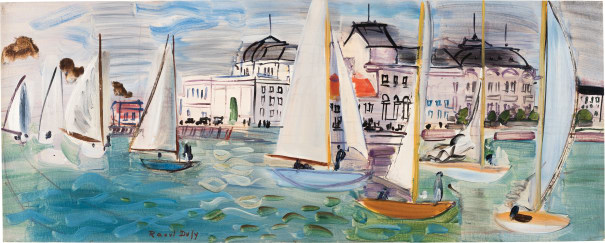
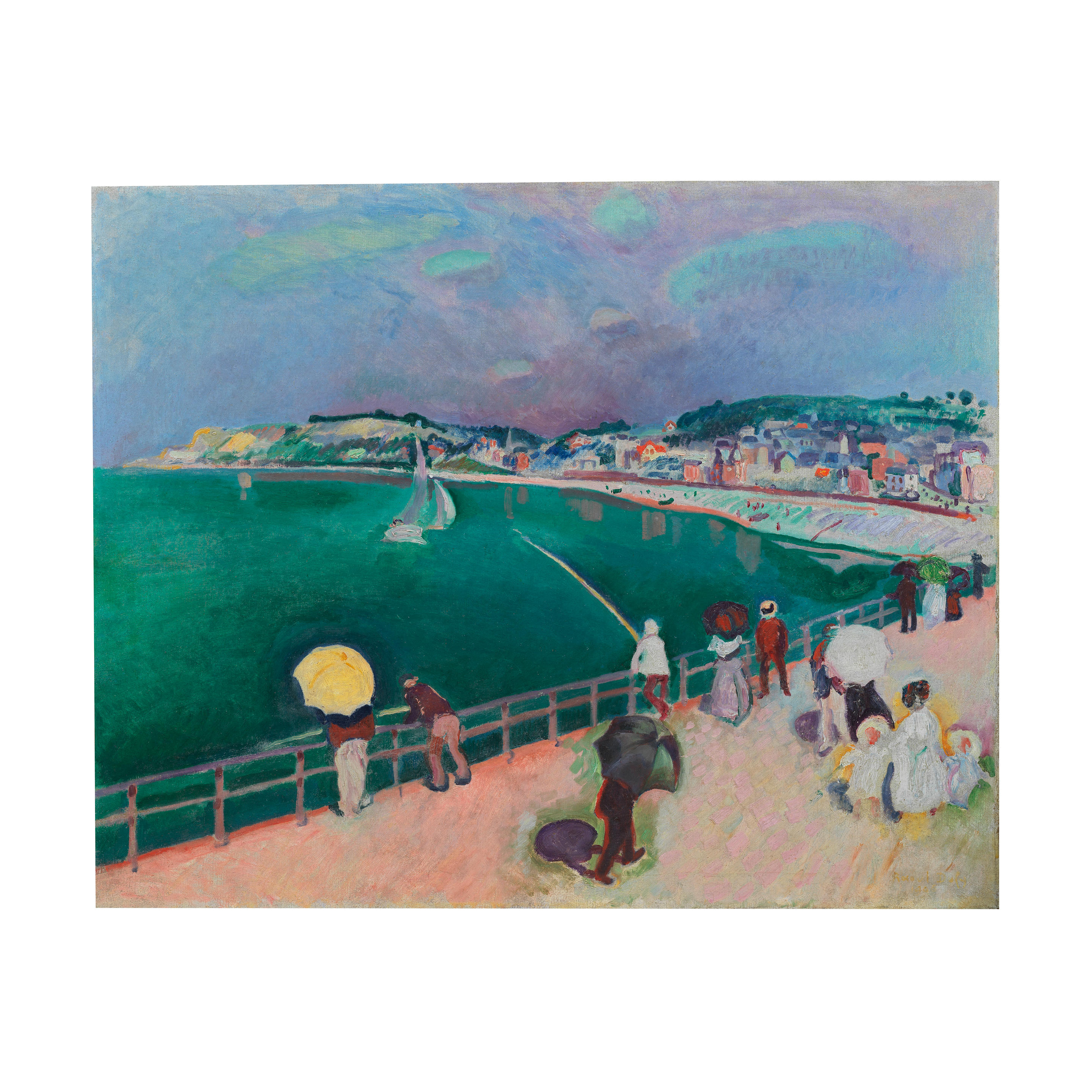

.jpg)


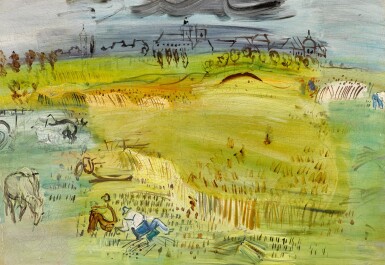


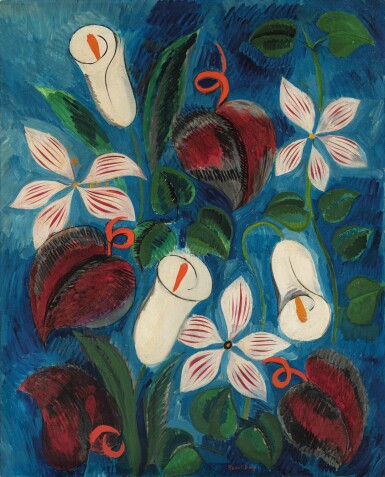



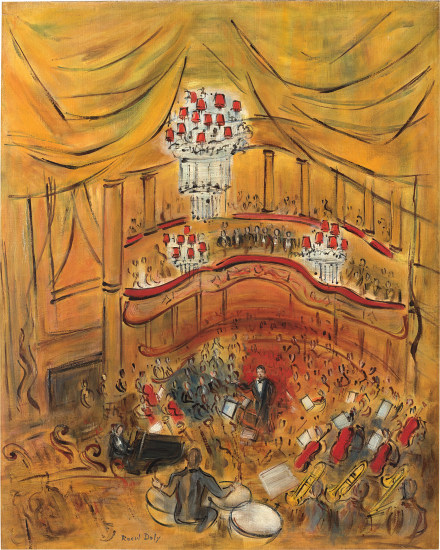
Try LotSearch and its premium features for 7 days - without any costs!
Be notified automatically about new items in upcoming auctions.
Create an alert